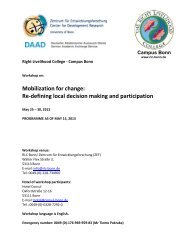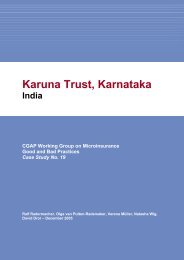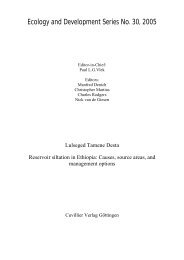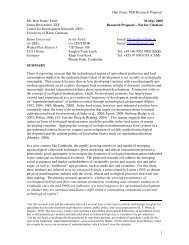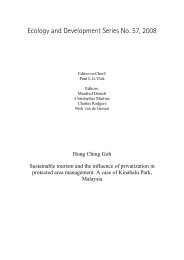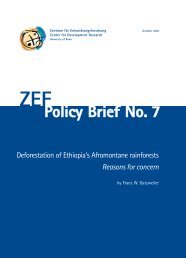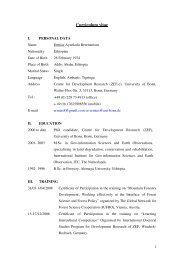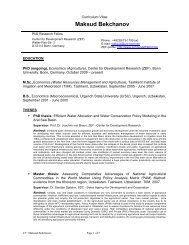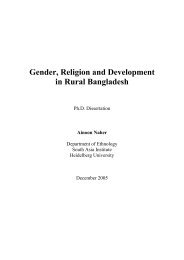Ecology and Development Series No. 10, 2003 - ZEF
Ecology and Development Series No. 10, 2003 - ZEF
Ecology and Development Series No. 10, 2003 - ZEF
- No tags were found...
Create successful ePaper yourself
Turn your PDF publications into a flip-book with our unique Google optimized e-Paper software.
Current state of knowledgeThe studies of Friis (1992) are the latest in the series of developments towards acomprehensive classification <strong>and</strong> mapping of the forest vegetation of Ethiopia. Accordingto these, seven vegetation types occur in Ethiopia, namely: Dry peripheral semi-deciduousGuino-Congolian forest, transitional rain forest, Afromontane rain forest, undifferentiatedAfromontane forest of the Ethiopian Highl<strong>and</strong>s, dry single-dominant Afromontane forest ofthe Ethiopian highl<strong>and</strong>s, dry single-dominant Afromontane forest of the escarpments <strong>and</strong>riverine forest. Four forest vegetation types among these occur in SW Ethiopia. Moredetailed descriptions of these forests, namely: (A) dry peripheral semi-deciduous Guineo-Congolian forest, (B) transitional rain forest, (C) Afromontane rain forest, <strong>and</strong> (D) riverineforest, are given below.2.1.1 Dry peripheral semi-deciduous Guineo-Congolian forestThe dry peripheral semi-deciduous Guineo-Congolian forests are restricted to the Barolowl<strong>and</strong>s, in Gambella State (formerly western part of the Illubabor administrative region).Chaffey (1979) was the first to make an inventory of such a forest. In the 1980s <strong>and</strong> later,several botanists <strong>and</strong> ecologists studied the forest. It occurs in a rather flat area with analtitudinal range of 450-600 m. The mean temperature is high, with a mean annualmaximum of 35-38 0 C <strong>and</strong> a mean annual minimum of 18-20 0 C. The mean annual rainfall isbetween 1300 mm <strong>and</strong> 1800 mm, <strong>and</strong> the wettest period is between May <strong>and</strong> September.The forest occurs mainly on rocky or s<strong>and</strong>y <strong>and</strong> well-drained soils, <strong>and</strong> is semideciduous,with a 15-20 m tall continuous canopy of Baphia abyssinica (which is endemicto southwestern Ethiopia <strong>and</strong> adjacent areas of the Sudan), mixed with less common speciessuch as Celtis toka, Diospyros abyssinica, Lecaniodiscus fraxinifolius, Malacanthaalnifolia, Trichilia prieureana, Zanha golungensis, <strong>and</strong> Zanthozylum leprieurii. Somespecies which emerge high above the main canopy are: Alstonia boonei, Antiaris toxicaria,Celtis gomphophylla, <strong>and</strong> Milicia excelsa. Small trees such as Acalypha neptunica,Erythroxylum fischeri, Tapura fischeri, Ziziphus pubescens, <strong>and</strong> Xylopia parviflora form acontinuous stratum below the canopy. The shrub layer is composed of Alchornea laxiflora,Argomuellera macrophylla, Mimulopsis solmisii, Oncoba spinosa, Oxyanthus speciosus,Rinorea ilicifolia, <strong>and</strong> Whitfieldia elongata.11



